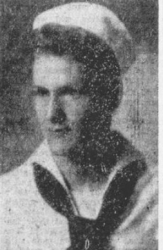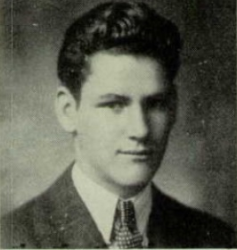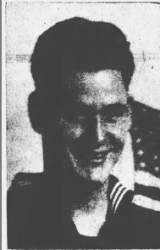
 |
|
|
||
|
CLARENCE CLINTON FOSTER 'TIM' |
||||
|
Engagements: • World War II (1941 - 1945) |
||||
| Biography: | ||||
|
Clarence was the son of Edgar Ray and Faye H. Johnston Foster. Edgar and Faye married on 23 Feb 1918 in Marysville, Marshall, KS. Clarence's siblings were Mary Alice Foster Carr and John Edgar Foster. Clarence, known to his friends as Tim, attended grade school in Blue Rapids and Topeka. Tim participated in a wide variety of high school activities. He was a member of the football, basketball, and track teams. He was a member of the senior play. He was also active in student government. He was a member of the Student Council. In his senior year, he was Class President. He was a graduate of Washburn Rural High School in Topeka, KS in June 1939. Clarence enlisted in the US Navy (NSN: 342-14-08) as an Apprentice Seaman (AS) on 04 Oct 1939 in Kansas City, MO. AS Foster reported for duty on board the battleship USS Mississippi (BB-41) on 23 Dec 1939 after he completed recruit training at the Naval Training Station, Great Lakes, IL. Several months later, he was advanced in rate to Seaman Second Class (S2c) on 04 Feb 1940 while the Mississippi was in the Navy Yard Puget Sound (NyPS) in Bremerton, WA. Later that year, S2c Foster decided to follow a different career field in the Navy so he changed his rate to Fireman 3c on 01 July 1940. F3c Foster rapidly completed study for the next high rate. He was advanced to Fireman Second Class (F2c) just six weeks later on 16 Aug 1940. After six months of on-the-job training and professional course study, F2c Foster was advanced in rate to Fireman First Class (F1c) on 15 Feb 1941. The following month F1c Foster was detached from Mississippi and transferred as a passenger to the ammunition ship, USS Nitro (AE-2), on 09 Mar 1941 for further transfer (FFT) to the Asiatic Fleet for duty. Nitro departed Pearl Harbor the next day bound for Midway Island and Guam then onward to Manila, Philippine Islands. She arrived on 29 Mar 1941 whereupon F1c Foster was transferred to Commander, Destroyer Squadron 29 (COMDESRON) for assignment. Foster was assigned to the USS Edsall (DD-219). He reported on board later that day for duty. In July 1941, as Japanese aggression intensified with their move south into lower Indo-China, Admiral Hart warned his officers that he had no doubt that war would come although he didn't know how of when it would start. Hart trained his destroyer crews hard keeping them on a war-footing for extended periods and away from Cavite naval base as much as possible exercising his "defensive deployment." Ordered to comply with the Asiatic Fleet CINC Adm. Thomas C. Hart's "defensive deployment" well south of Manila, units of the Asiatic Fleet, including destroyer tender USS Blackhawk (AD-9), USS Edsall (DD-219) and other ships of Destroyer Division (DesDiv) 57, got underway on 25 Nov 1941, and arrived on the morning of 29 Nov 1941 in Balikpapan, a major oil port on the eastern coast of Borneo. On 01 Dec 1941, F1c Foster received a double advancement in rate to Machinist Mate Second Class (MM2). A week later Edsall, an element of Destroyer Division 57 (DESDIV) was enroute to Batavia (Djakarta) when word of the attacks on Pearl Harbor was received. The division altered course to Singapore to act as ASW screen for Force Z. From Singapore, Edsall was sent to search for survivors of HMS Prince of Wales and HMS Repulse, sunk off Malaya on 10 Dec. No survivors were found. For the next month, Edsall and other units of DESDIV 57 were used to escort shipping to and from Australia. It was on one of these escort trips that Edsall participated in the sinking of IJN submarine (I-124) off Darwin. Several days later, Edsall was damaged during another attack on a suspected submarine. One of Edsall's depth charges exploded prematurely in shallow water damaging one of Edsall's propeller shafts. This damage would play an important role in her eventual sinking. On 3 February, Edsall and other American units of the American-British-Dutch-Australian Force (ABDA) moved up to Tjilatjap, Java in order to be closer to the combat theater and refueling facilities. She continued her service as a patrol vessel off southern Java. On 26 February, she steamed from Tjilatjap with her sister ship USS Whipple (DD-217) to rendezvous with the converted seaplane tender USS Langley (AV-3) carrying P-40E fighters and crews for the defense of Java. On 27 February, the Langley, along with Edsall and Whipple, came under attack by sixteen (16) Mitsubishi G4M "Betty" bombers of the Japanese 21st and 23rd Naval Air Flotillas and escorted by fifteen (15) A6M Reisen fighters. The attack fatally damaged Langley. She had to be abandoned and later scuttled by Whipple. Edsall rescued 177 survivors and Whipple rescued 308. On 28 February, the two destroyers rendezvoused with the fuel replenishment ship USS Pecos (AO-6) off Flying Fish Cove, Christmas Island some 250 miles southwest of Tjilatjap. A sudden attack by land based Japanese bombers forced Edsall and the other ships to head for the open sea. They headed directly south into the Indian Ocean for the rest of 28 February in high winds and heavy seas. Early in the pre-dawn hours of 1 March, Whipple and Edsall transferred all the Langley survivors to Pecos. There were now close to 700 personnel aboard Pecos. Whipple then set off for Cocos Islands as protection for the tanker Belita sent to meet her there. The Pecos, carrying a large number of survivors was ordered to Australia. Edsall had retained 32 USAAF personnel from Langley needed to assemble and fly an additional 27 P-40E fighters shipped to Tjilatjap aboard the transport Sea Witch. Edsall was instructed to return these "fighter crews" to Tjilatjap. At 0830, she reversed course and headed back to the northeast for Java. At noon that day, planes from Japanese aircraft carrier Soryu attacked Pecos and struck again an hour later. Finally, in mid-afternoon, third and fourth strikes from aircraft carriers Hiryu and Akagi fatally wounded the Pecos. While under attack, Pecos radioed for help. After Pecos sank, Whipple returned to the scene intentionally arriving after dark. She eventually rescued 232 survivors. Many other survivors, although visible to crewmembers on board Whipple, had to be abandoned at sea because Whipple made sonar contact with what was believed to be several Japanese submarines. It was just too dangerous for her to remain in the area. Edsall may have heard Pecos call for help. Maybe trying to help her stricken comrades, Edsall had reversed course and stumbled upon the Kido Butai commanded by Admiral Nagumo. Unfortunately, Edsall was spotted first. IJN battleships Hiei and Kirishima and heavy cruisers Tone and Chikuma attacked Edsall with surface gunfire. Edsall began evasive maneuvers, frustrating the Japanese for the next hour and a half. However, because of the damage done previously to one of her propeller shafts, Edsall was unable to make top speed or maneuver fully. At one point Edsall turned and launched her torpedoes narrowly missing Chikuma. The Japanese fired 1400 rounds resulting in only one or two direct hits. The frustrated Japanese commander, Admiral Nagumo, called for attacks by aircraft from his carriers. Three of the carriers sent dive-bombers who scored a number of hits and set the Edsall on fire. The Edsall went down at 7pm, 430 miles south of Java. Thus, the heroic but little known battle was fought in the early months of WWII. Because no known survivors lived to tell the story, Edsall’s heroism and resolve against overwhelming odds were fully written more than a half a century later. The final muster report shows the disposition of the entire crew of the USS Edsall (DD-219). MM2 Clarence Clinton Foster was listed as missing in action on 01 Mar 1942. He was presumed dead on 25 Nov 1945. His remains were unrecoverable. He was posthumously awarded the Purple Heart, American Defense Service Medal with “Fleet” clasp, Asiatic-Pacific Campaign Medal with two bronze stars, the Philippine Defense Medal, and the World War II Victory Medal. He may also be eligible for the Combat Action Ribbon (est. 1969 backdated to 07 Dec 1941). After WWII ended, an Allied War Crimes Tribunal was convened in Java. During the course of the Tribunal's investigations, an eyewitness to Japanese executions was discovered and interviewed. He testified that he witnessed the execution by the Japanese of a number of POWs in 1942. He led investigators to the Japanese Execution Grounds mass grave, Kendari II, Celebes, N.E.I. *Five sets of remains in a group of about 10 were later identified from ID tags as USS Edsall crewmen. The other five were unknown but were possibly US Army Air force personnel on board Edsall from the Langley. A sixth set of remains were found in another burying ground on Celebes. They were identified by an ID tag as those of Fireman Second Class (F2) Loren Stanford Myers, a crewman from the Edsall. All of these remains were disinterred and reburied in the US Military Cemetery, Barrackpore, India on 12 Nov 1946. After three years, their remains were disinterred again and reburied in a mass grave at the National cemetery at Jefferson Barracks, St. Louis, MO on 20 Dec 1949. The remains of F2 Myers were reinterred according to immediate family wishes in the National Memorial Cemetery of the Pacific in Honolulu, HI on 31 Mar 1950. With the discovery of these remains, their presumed date of death was amended to 02 Mar 1942.------------------------- His family received a commemoration in honor of Petty Officer Foster's service from President Harry S. Truman. It reads: In Grateful Memory of Clarence Clinton Foster, Who Died In The Service Of His Country At Sea, Asiatic Area, attached U.S.S. Edsall, 25 November 1945 (presumed). He stands in the unbroken line of patriots who have dared to die that freedom might live, and grow, and increase its blessings. Freedom lives, and through it, he lives – in a way that humbles the undertakings of most men. Signed, Harry Truman President of the United States of America ----------------------- Bio#14 by Gerry Lawton (GML470) |
||||
| Honoree ID: 136822 | Created by: MHOH | |||
Ribbons
Medals
Badges
Honoree Photos
 |  |  |
 |  |
 |


